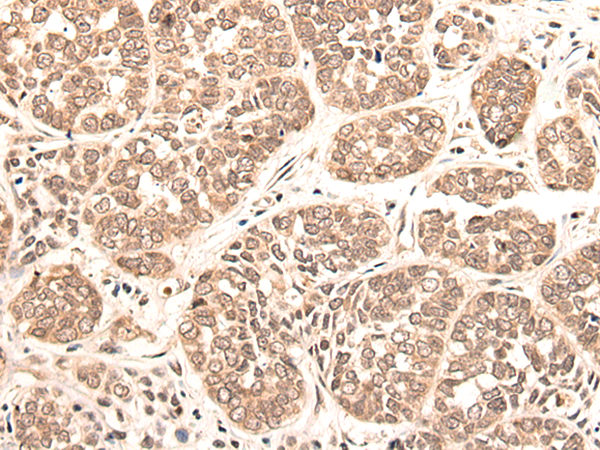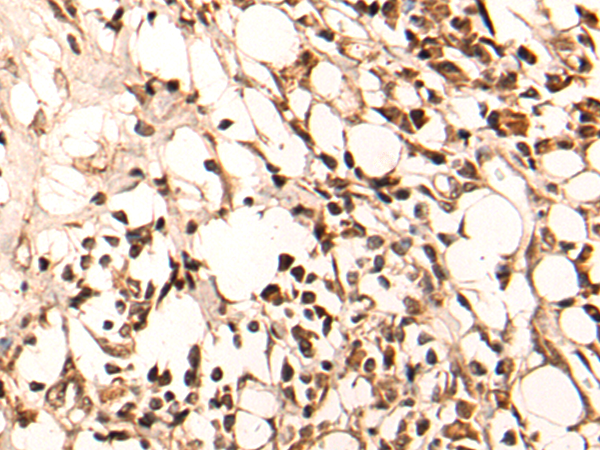

| WB | 咨询技术 | Human,Mouse,Rat |
| IF | 咨询技术 | Human,Mouse,Rat |
| IHC | 1/25-1/100 | Human,Mouse,Rat |
| ICC | 技术咨询 | Human,Mouse,Rat |
| FCM | 咨询技术 | Human,Mouse,Rat |
| Elisa | 1/5000-1/10000 | Human,Mouse,Rat |
| Aliases | KRML; MCTO |
| Host/Isotype | Rabbit IgG |
| Antibody Type | Primary antibody |
| Storage | Store at 4°C short term. Aliquot and store at -20°C long term. Avoid freeze/thaw cycles. |
| Species Reactivity | Human, Mouse, Rat |
| Immunogen | Synthetic peptide of human MAFB |
| Formulation | Purified antibody in PBS with 0.05% sodium azide and 50% glycerol. |
+ +
以下是3篇关于MAFB抗体的参考文献及其摘要概括:
---
1. **文献名称**:*MAFB is a tissue-specific marker of plasmacytoid dendritic cells*
**作者**:C. C. Bain et al.
**摘要**:该研究通过免疫组化(IHC)和流式细胞术分析,证实MAFB蛋白在浆细胞样树突状细胞(pDCs)中特异性表达,可作为其特异性标记物。研究还表明,MAFB抗体在区分pDCs与其他免疫细胞亚群中具有重要应用价值。
---
2. **文献名称**:*MAFB as a novel diagnostic marker for histiocytic sarcoma and related tumors*
**作者**:K. Yoshida et al.
**摘要**:作者通过比较多种组织细胞肿瘤的免疫表型,发现MAFB抗体在组织细胞肉瘤和部分组织细胞增生症中呈高特异性染色,提出MAFB可作为临床病理诊断中新的辅助标记物,尤其在鉴别多发性骨髓瘤与组织细胞源性肿瘤时效果显著。
---
3. **文献名称**:*Role of MAFB in oncogenic pathways of pancreatic cancer*
**作者**:M. Kimura et al.
**摘要**:研究利用MAFB抗体进行免疫沉淀和染色质免疫共沉淀(ChIP)实验,揭示了MAFB在胰腺癌中通过调控下游靶基因(如CDKN1A)促进肿瘤细胞增殖和转移的分子机制,为靶向治疗提供了潜在方向。
---
4. **文献名称**:*MAFB expression in osteoclastogenesis and bone remodeling*
**作者**:S. L. Teitelbaum et al.
**摘要**:该研究通过基因敲除和MAFB抗体染色技术,发现MAFB在破骨细胞分化过程中起关键作用,其缺失会导致骨吸收功能异常,为骨质疏松等骨代谢疾病的机制研究提供了实验依据。
---
这些文献覆盖了MAFB抗体在免疫细胞标记、肿瘤诊断、癌症机制及骨生物学等领域的应用,均为领域内代表性研究。
MAFB antibody targets the MAFB protein, a transcription factor belonging to the large Maf protein family. MAFB (v-maf musculoaponeurotic fibrosarcoma oncogene homolog B) plays critical roles in cell differentiation, development, and tissue homeostasis. It regulates gene expression by binding to specific DNA sequences, often in combination with other transcription factors. MAFB is essential in various biological processes, including hematopoiesis, osteoclast differentiation, and pancreatic β-cell function. Its expression is tightly controlled, with notable activity in macrophages, keratinocytes, and certain epithelial cells. Dysregulation of MAFB has been implicated in diseases such as multiple myeloma, where chromosomal translocations lead to its overexpression, and in metabolic disorders linked to pancreatic dysfunction.
MAFB antibodies are widely used in research to detect and quantify MAFB protein levels in techniques like Western blotting, immunohistochemistry (IHC), and immunofluorescence (IF). These antibodies aid in studying MAFB's role in cellular differentiation, immune responses, and cancer progression. They are critical for validating MAFB knockout models and exploring its interactions with signaling pathways like NF-κB. High-quality MAFB antibodies are validated for specificity, often through knockout controls, and are available in monoclonal or polyclonal formats. Researchers rely on these tools to investigate MAFB's dual roles as both an oncogene and tumor suppressor, depending on cellular context, advancing understanding of its therapeutic potential in disease management.
×